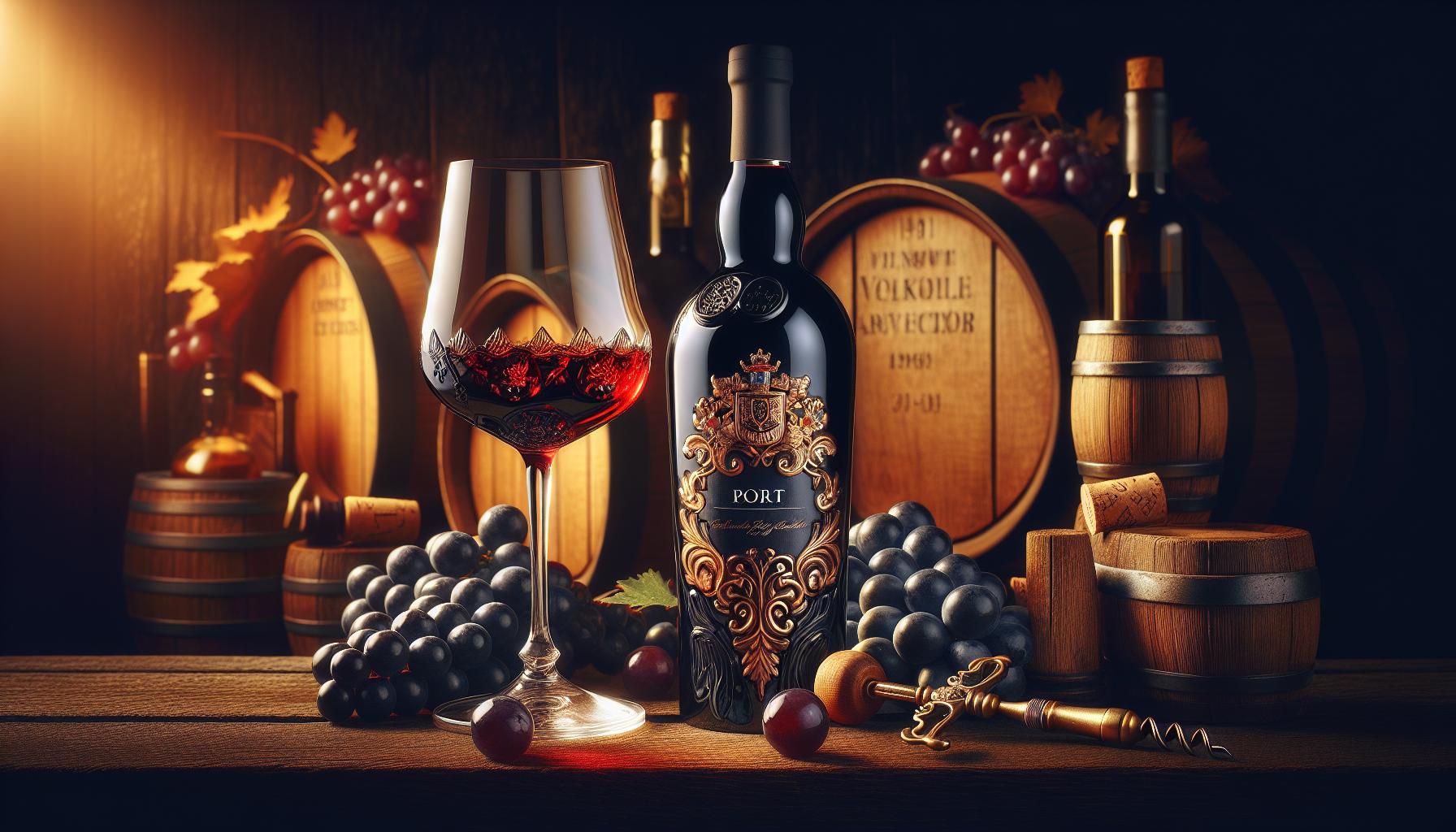Port wine, with its rich flavors and storied heritage, captivates those with a penchant for indulgence in the world of wine. Often associated with sweetness, the truth about port wine’s diverse styles reveals a tapestry of tastes that range from lush and sweet to dry and complex. Whether you’re a seasoned connoisseur or just beginning your exploration of fortified wines, understanding the nuances of port can elevate your appreciation.
Did you know that port wine’s origins date back to the 17th century, when British merchants began to fortify wines from Portugal’s Douro Valley? This fascinating history is just the beginning of what makes port a unique and appealing choice for any occasion. As we delve into the intricacies of different port styles-Ruby, Tawny, Vintage, and beyond-you’ll uncover how each offers a distinct experience for the palate. Join us on this journey to discover how to choose the perfect port for your next gathering, meal, or quiet evening at home, and unravel the sweet mysteries that make this wine a cherished delight.
Understanding the Sweetness of Port Wine
Port wine, a luscious elixir originating from the sun-drenched hills of Portugal’s Douro Valley, entices lovers of rich sweetness with every sip. What captivates many is not merely the sugar content, but the harmonious complexity woven into each bottle. The sweetness of Port stems from its unique production method, which involves partially fermenting the grape must before adding distilled grape spirit. This fortification halts fermentation, leaving residual sugars intact and bestowing the wine with its trademark sweetness while also elevating its alcohol content.
Understanding this delightful sweetness requires an appreciation of the diverse types of Port. While all Ports share the foundation of sweet profiles, the nuances vary dramatically across styles. At one end, you have Ruby Port, known for its vibrant, fruit-forward character, reminiscent of fresh berries and cherries. The deep, youthful flavors make it a favorite among those who revel in straightforward sweetness. On the other end lies Tawny Port, a more sophisticated elderly version, which often presents a tapestry of dried fruits, nuts, and toasted caramel-a rich confection that unfolds gradually on the palate, reflecting its time spent aging in oak barrels.
Ultimately, the sweetness of Port wine is not just a matter of sugar content but a celebration of the region’s traditions and craftsmanship. Each glass embodies a story of sun-soaked vineyards, meticulous selection of indigenous grape varieties like Touriga Nacional and Tinta Roriz, and the expert hands that cultivate, ferment, and age these exquisite wines. Embracing Port invites an exploration into a world where every sip encourages you to slow down, savor the layered flavors, and engage in the rich history and culture of one of the world’s most beloved fortified wines.
The Historical Roots of Port Wine
Port wine’s journey through history is as rich and layered as the drink itself, tracing back to the 17th century when British merchants first began to import wine from Portugal. The Douro Valley, characterized by its steep terraced vineyards and vigorous climate, became the heart of this endeavor. The English, faced with a wine shortage due to disruptions in trade with France, turned to Portugal’s flavorful offerings. Initially, the wines were not designed to be sweet; however, it was soon discovered that fortifying wine with brandy was a popular solution to maintain stability during transport. This process not only preserved the wine but also enhanced its sweetness, paving the way for what we now recognize as Port.
As the demand for a sweeter, more robust wine grew, Port established itself as a beloved choice among nobility and wine enthusiasts across Europe. The regulation of Port production began around the early 18th century, leading to stringent guidelines that defined the identity of Port wine. The establishment of the Douro Demarcated Region in 1756 was a monumental milestone, marking it as the first wine region in the world to be officially demarcated and protected by law. This not only ensured quality but also celebrated the complex interplay of terroir, grape varieties, and traditional winemaking practices that define Port today.
Reflecting on this historical backdrop invites deeper appreciation for the wine in your glass. Every sip of Port carries echoes of its storied past-from the sun-kissed fruits of the Douro Valley to the skilled hands of the winemakers who crafted each bottle. The longstanding tradition of aging the wine in both barrels and bottles allows flavors to evolve, resulting in a nuanced experience that tells a tale of time, place, and people. In a way, each glass is a passport to the centuries of history, culture, and craftsmanship that have contributed to the sweet richness we now relish. As you indulge, remember that Port is more than a sweet beverage-it encompasses a dynamic narrative of exploration, trade, and enduring legacy that continues to delight palates worldwide.
Exploring Different Styles of Port Wine
Port wine, with its sun-drenched vineyards and rich heritage, unfolds not just as a drink but as an exploration of styles, each echoing the terroir, tradition, and artistry of its makers. Originating from the unique conditions of the Douro Valley in Portugal, Port is distinguished primarily by its fortification which halts fermentation, leaving behind those delightful sugars that define its sweetness. But beyond that, Port offers a tantalizing array of styles that can cater to every palate, inviting enthusiasts to discover their preferences within this captivating category.
Among these styles, Ruby Port stands as a vibrant representation of youth and exuberance. Known for its deep red hue, Ruby is typically aged for a shorter period in large oak barrels, preserving its fruity character and robust tannins. This style showcases bold flavors of cherry, raspberry, and plum, ensuring a lively, straightforward drinking experience that’s perfect for pairing with chocolate desserts or sipping on a warm evening. Tawny Port, on the other hand, tells a different story, one of aging and complexity. Aged in smaller barrels, Tawny Ports develop nutty, caramel-like flavors interwoven with dried fruits and spices. This transformation through oxidation gives the wine its characteristic amber color, leading to a sipper that enjoys fine company with cheeses, nuts, or even a great book by the fireplace.
For those who seek a more refined experience, Vintage Port represents the pinnacle of Port production, made exclusively in declared years where grapes reach exceptional quality. This style undergoes extended bottle aging, resulting in intense complexity and rich layers of flavor. Expect to find a spectrum ranging from dark berries to cocoa, often paired with long-lived wines that benefit from years of maturation. Seasoned aficionados relish the anticipation of tasting Verde Port, which becomes a story unto itself, as it evolves over decades, much like a cherished friendship.
Then there’s the delightful and often underappreciated LBV (Late Bottled Vintage) Port. This style offers a bridge between Ruby and Vintage, aged longer before bottling yet still retaining the lush fruit flavors typical of a young Ruby. LBVs deliver a fantastic balance of accessibility and complexity, making them a superb choice for casual gatherings or dinners.
As we journey through these styles, the significance of choice becomes evident. Each bottle you uncork is more than just alcohol; it encapsulates the story of the region, the vintage, and the very essence of its makers. The richness of Port lies not only in its sweetness but in the myriad of expressions it offers, encouraging exploration and discovery with each sip. Whether you prefer the youthful exuberance of a Ruby, the contemplative depth of a Tawny, or the classic finesse of a Vintage, there remains a kind of magic in finding the Port that resonates perfectly with your own palate. Cheers to that journey!
What Makes Port Wine Sweet?
Port wine possesses an intrinsic sweetness, a characteristic that enchants many wine lovers and invites deeper exploration. This signature sweetness arises primarily from the unique process of fortification, where grape spirits are added to the wine during fermentation. This act halts the fermentation process before all the natural sugars from the grapes have been converted to alcohol, preserving a delightful sweetness that is often perceived as rich and luscious. Imagine the way sunlight kisses the ripe grapes in the Douro Valley, locking in not just the sugars but also the essence of the terroir.
Different styles of Port wine bring varied expressions of sweetness to the glass, shaped by factors such as grape variety, age, and production methods. Ruby Ports, marked by their vibrant color and youthful exuberance, often display a pronounced fruitiness with luscious flavors of cherry, raspberry, and plum. These bold flavors combine harmoniously with the residual sugars, creating a refreshing sweetness that makes them particularly enjoyable when paired with desserts or simply savored alone. On the other hand, Tawny Ports, enriched by years of aging in smaller barrels, exhibit a complex sweetness characterized by nutty and caramelly notes. The integration of dried fruit flavors-like fig and apricot-deepens the experience, delivering a more contemplative sip that encourages one to slow down and relish each moment.
The beauty of Port wine lies in its ability to transform sweetness into a narrative, where each sip tells a story of climate, culture, and the artistry of winemakers. Take, for instance, Vintage Ports. These wines undergo extensive aging in the bottle, allowing their natural sugars to meld seamlessly with intricate layers of flavor, from dark chocolate to spice. As they evolve, one can experience how sweetness dances gracefully on the palate, revealing the character of the land and its vintage.
For those embarking on their journey into the world of Port, it’s essential to consider the context of sweetness in relation to food pairings. Sweetness can create a harmonious balance, particularly with offerings like strong cheeses, chocolate desserts, or even spiced meats. As you explore the complexities of Port, remember that sweetness is but one ribbon in the rich tapestry of flavors waiting to be discovered. Embrace the adventure, and let each bottle guide you through the lush vineyards and timeless traditions that make Port wine a cherished companion for both special occasions and quiet evenings.
Comparing Ruby, Tawny, and Vintage Ports
The vibrant world of Port wine captivates the senses with its diversity and complexity. Among its many styles, Ruby, Tawny, and Vintage Ports stand out as quintessential expressions, each weaving its own tale of flavor, aging, and craftsmanship. Understanding these differences not only enhances appreciation but also enriches food pairing and tasting experiences, making each sip an adventure.
Ruby Port, often lauded for its youthful exuberance, bursts forth with bright red fruit flavors such as cherry, raspberry, and plum. This type is typically aged in large oak casks, preserving its lively character and deep color. The natural sugars from the grapes, intensified by a relatively short aging process, yield a sweet, juicy profile that makes Ruby Ports incredibly versatile. They shine with chocolate desserts, fruit tarts, or even rich cheeses, showcasing a refreshing sweetness that delights the palate.
Tawny Port, in contrast, whispers of patience and complexity. Aged in smaller barrels, it undergoes oxidative aging, allowing it to lose color while gaining layered flavors. Notes of nuts, caramel, and dried fruits create a sumptuous body that speaks to its time spent maturing. The sweetness here is more nuanced and rich, inviting moments of reflection. Enjoying Tawny with a slice of pecan pie or alongside a cheeseboard featuring blue cheese and figs reveals the harmony found in contrasting flavors, elevating both wine and food.
Vintage Port represents the pinnacle of Port making, crafted from grapes of a single exceptional year. These wines are bottled young, allowing them to evolve beautifully over time, gaining depth and character. They often exhibit intense flavors of dark fruits, spices, and even hints of chocolate. Although naturally sweet, the balance of tannins and acidity ensures that the sweetness is not overwhelming, creating a luxurious experience. Pairing Vintage Ports with dark chocolate desserts or stilton cheese can elevate an occasion, transforming it into an unforgettable culinary celebration.
As you explore these styles, consider how the interplay of sweetness manifests in each glass. Whether you find yourself captivated by the exuberance of Ruby, the contemplative richness of Tawny, or the intricate depth of Vintage, the world of Port wine is an invitation to savor each moment, sip by sip. The beauty lies not just in the drink itself, but in the stories and experiences shared over a glass, making Port wine a true celebration of life and connection.
The Role of Fortification in Port Wine
The process of fortification is the heart and soul of what distinguishes Port from other wines, a step steeped in both practicality and history. By adding distilled grape spirit-often a high-proof brandy-during fermentation, winemakers halt the sugar transformation into alcohol. This not only preserves the natural sweetness of the grapes but also elevates the alcohol content, resulting in a lush, rich wine that is both pleasurable and complex. Imagine a young winemaker in the 17th century, looking to protect his wine from spoilage on a long sea voyage to England; this clever technique became a celebrated signature of Portuguese wine culture known as Port.
This dual process of sweetening while fortifying creates a delightful balance that defines Port’s character. The retained natural sugars-often from expressive Portuguese grape varieties like Touriga Franca and Tinta Roriz-infuse the wine with layers of complexity. As the wine ages, these sugars harmoniously meld with other elements, producing intriguing characteristics that make sampling different styles of Port an exciting sensory journey. For instance, a Tawny Port, which undergoes oxidative aging, reveals flavors of caramel and nuts, a testament to how fortification influences more than just sweetness but also texture and depth.
As you delve into the world of fortified wines, consider how this practice shapes your tasting experience. A well-crafted Port should not be merely sweet; it should resonate with flavors that echo its lineage and environment. Seek out Ports that tell a story, whether they reflect the traditional winemaking techniques from the Douro Valley or innovative twists on this ancient style. Embrace the complexity provided by fortification, allowing it to guide your palate through a delightful exploration of rich fruity essences, nutty undertones, and subtle hints of spice, all held together by the inviting embrace of sweetness.
Ultimately, understanding fortification is not merely an exercise in viniculture but rather an invitation to engage in a deeper appreciation of wine as a cultural artifact. Each bottle of Port embodies centuries of evolving techniques and traditions, inviting you to connect with the cultural tapestry of Portugal-a blend of history, artistry, and the enduring celebration of life captured in each sip. So next time you pour a glass of Port, remember, you’re experiencing more than sweetness; you’re savoring a legacy.
Tasting Notes: How to Experience Port Wine
Experience the enchanting world of Port wine, where each sip invites you to unravel layers of flavor, history, and emotion. Imagine holding a glass filled with this fortified delight, its rich hue reflecting the sun-drenched vineyards of the Douro Valley. A well-structured tasting begins long before you even lift it to your lips-it starts with observing the wine’s appearance. Take a moment to appreciate its depth and clarity, swirling it gently to witness how it clings to the glass, releasing a tapestry of aromas. This sensory exploration is your gateway to an intimate understanding of Port.
When inhaling the fragrant bouquet, allow your senses to wander. Different styles of Port each tell a unique story. A classic Ruby Port offers an explosion of vibrant fruit notes-think luscious blackberries, ripe plums, and a whisper of cherries. In contrast, when sampling an aged Tawny, the aroma shifts beautifully toward deeper, more complex elements like caramel, toasted nuts, and dried fruits characterized by its oxidative aging. It’s this evolution of scents that speaks to the craftsmanship behind the bottle.
As you take your first sip, consider the balance between sweetness and acidity-a hallmark of well-made Port. Let it linger on your palate, noting its velvety texture, perhaps punctuated by hints of spice or chocolate. Each sip is a reminder of the Portuguese land where tradition and innovation intertwine. Pairing your tasting experience with specific foods can elevate these flavors even further. Rich desserts, like dark chocolate torte or a creamy blue cheese, harmoniously accentuate the wine’s sweetness, transforming your tasting into a full sensory feast.
In your journey through the diverse styles of Port, allow yourself to engage not just analytically but emotionally. Reflect on how the stories of the grape varieties-like the robust Touriga Nacional or the aromatic Touriga Franca-connect with the wine as you savor its richness. Remember, wine tasting is not merely a mechanical process; it’s an art form, a celebration of culture, and a testament to the enduring spirit of craftsmanship. Open your heart to the nuances, allowing each glass to be a novel waiting for you to turn its pages.
Food Pairing: Best Matches for Port Wine
Port wine, with its luscious sweetness and rich histories, is not just a delight to sip but a versatile companion at the table. When considering what to pair with this fortified wine, the key lies in embracing its sweetness while balancing it with the appropriate flavors of your meal or dessert. The right combinations can transform an ordinary evening into a festive celebration of taste, culture, and creativity.
Decadent Desserts
For those with a penchant for the sweeter side of life, the classic pairing of Port with desserts is truly a match made in gastronomic heaven. Rich and plush Ruby Ports resonate beautifully with desserts like dark chocolate torte, where the wine’s berry notes amplify the dessert’s chocolatey depths. A blue cheese platter is another delectable choice; the salty, creamy elements of the cheese enhance the wine’s richness. An encore of fruit tarts or even a spiced apple crumble makes for a harmonious union, as the natural sweetness of the fruit complements Port’s profile.
Cheeses and Charcuterie
Venture beyond sweets, and you’ll find that Port pairs remarkably well with a variety of cheeses. A robust Tawny Port, famed for its complexity, marries exquisitely with aged cheeses like cheddar or parmigiano-reggiano, where the wine’s nutty, caramel notes echo the cheese’s savory qualities. Adding a charcuterie board into the mix adds a delightful umami punch-think along the lines of prosciutto or spiced salami-to elevate your Port experience and create layers of flavor.
Spicy and Savory Dishes
For the adventurous palate, exploring savory pairings presents an exciting opportunity. Wines like Late Bottled Vintage Port can hold their own against spicy dishes, such as barbecue ribs or even curried lamb, where the wine’s sweetness counterbalances the heat, creating a delightful interplay of flavors. Try Indian curries that utilize cream or coconut milk to marry seamlessly with the wine’s fruit-forward character.
Ultimately, the art of pairing Port wine is less about strict rules and more about the joyful exploration of flavors-a celebration of taste that encourages you to discover what bowls and glasses can come together to create delightful experiences. So, whether you lean towards the sweet and rich, the savory and umami-loaded, or an adventurous blend of both, let your palate guide you through an enchanting culinary adventure with Port wine at the heart of it.
Port Wine Production: A Cultural Journey
The production of Port wine is not merely a process; it is a cultural journey that intertwines centuries of tradition, artistry, and the enchanting landscapes of the Douro Valley in Portugal. This unique territory-a UNESCO World Heritage site-is characterized by its steep terraced vineyards, which seem to cascade down to the river below, revealing the labor and dedication of generations of vintners who have embraced the art of winemaking. While the allure of Port wine is its rich sweetness, understanding its production reveals layers of cultural significance that enhance every sip.
Walking through the vineyards, you are transported back in time. The method of cultivating grapes for Port has roots that extend to the Romans and the Moors, who recognized this fertile region’s potential. Today, many Port producers still employ traditional methods such as foot-treading, where grapes are gently crushed by foot in shallow stone lagars, allowing for the perfect extraction of juice while preserving the essence of the fruit. This time-honored practice not only offers a unique flavor but also celebrates a communal spirit; it’s often a festive occasion where family and friends gather to partake in the harvest.
The Fortification Process
A pivotal moment in the creation of Port is the fortification process. At a specific point during fermentation, grape spirit is added to stop the process and retain the natural sugars, leading to that beloved sweetness. This fortification not only balances the wine’s body and alcohol content but also serves as a testament to the region’s innovation during the 17th century, when British merchants sought a more stable product to enhance longevity during long sea voyages. The blending of cultures-the Portuguese terroir and the British taste for sweet wines-fostered an extraordinary evolution in wine production, transforming Port into an international phenomenon.
As you delve deeper, the diversity of styles-Ruby, Tawny, and Vintage-reflects the intricate artistry of the winemakers, each with its method tailored to capture the essence of the grape and the spirit of the region. For example, aged in wooden barrels, Tawny ports develop complex nutty flavors and a rich aroma of dried fruits, merging centuries of heritage with modern palates. It vividly illustrates how tradition and innovation can coexist, guiding producers to continually elevate the quality and experience of Port wine.
Ultimately, indulging in Port is a multi-sensory experience that invites you not just to enjoy a glass but to appreciate the history and culture that beautifully enfolds it. Each bottle is a time capsule, carrying stories of land, labor, and love, making it a perfect accompaniment for moments of celebration or quiet reflection. And as you savor its sweetness, it offers a delicious reminder of the rich tapestry that is woven into every drop.
The Evolution of Port Wine: Trends and Innovations
The journey of Port wine is a living tapestry, woven with threads of tradition and innovation. In recent years, the industry has witnessed a remarkable evolution, blending the deep-seated practices of the Douro Valley with contemporary trends that cater to a global audience. Think of the rise of high-quality non-vintage Ports, which allow consumers to access the rich, luscious flavors of this fortified wine without the premium price tags often associated with vintage options. These offerings invite a broader demographic to experience Port, not as an afterthought but as an integral part of everyday enjoyment, thus challenging the perception of Port as merely a dessert wine.
Producers have become increasingly attentive to market demands, experimenting with innovative aging techniques and unorthodox blending practices. Hailing from the heart of Portugal, winemakers are tapping into lesser-known grape varieties, introducing freshness and complexity previously unseen in traditional Port styles. Names like Touriga Nacional and Tinta Roriz remain predominant, but the inclusion of native grapes such as Tinta Barroca creates captivating flavor profiles that surprise even the most fabled connoisseurs. The meticulous attention to detail isn’t limited to the grapes alone; cutting-edge technology now enhances the winemaking process, from fermentation monitoring to capsule corking that ensures longevity while keeping the wine’s character intact.
As the palate of modern wine drinkers evolves, so too does the approach to food pairings. Port is no longer confined to blue cheese or chocolate desserts-it is now being celebrated in culinary diversity. Today, chefs craft inventive dishes that highlight Port’s versatility; imagine a savory reduction paired with braised meats or a delicate sauce enhancing the flavors in seafood. This integration into the culinary landscape not only expands the possibilities for enjoying Port but also enhances its reputation as a sophisticated choice for both everyday meals and elegant dinner parties.
On the horizon, sustainability trends are reshaping the Portuguese wine industry. Many producers are leaning towards organic and biodynamic methods, paying homage to the land that has given so much to their craft. This commitment to sustainability not only preserves the environment but also resonates with a more environmentally conscious consumer base, further solidifying wine’s role as an experience that harmony can promote, connecting the lush, vibrant terroir to the pleasurable escapism each glass provides.
As one takes a sip of Port, it’s not just tasting a beverage; it’s partaking in a narrative that blends the old with the new, reflecting a commitment to preserving tradition while embracing innovation. Each bottle tells a story, not merely of grapes and fermentation processes, but of human creativity, adaptability, and an enduring passion that continues to make Port a beloved choice worldwide.
How to Choose the Right Port Wine for You
Selecting the right Port wine can feel like stepping into a labyrinth of flavors, styles, and regions, but fear not-this journey can transform into an enriching experience. Port is not merely a wine; it’s a story bottled, a ritual steeped in centuries of tradition, and tasting it can be akin to savoring history itself. Understanding what you truly desire from your Port can guide you toward a selection that resonates with your palate and complements your moments.
When embarking on your Port adventure, consider beginning with the basic styles, which can dramatically shape your tasting experience. For instance, Ruby Ports are vibrant and fruit-forward, often brimming with the essence of fresh berries, making them ideal for those who appreciate a bold, sweet sip. In contrast, Tawny Ports possess a nuanced complexity; their aging in wooden casks introduces layers of caramel, nut, and spice, catering to those who delight in subtlety and warmth. Vintage Ports, a rare and celebrated category, encapsulate the very essence of a particular year’s harvest. Imagine enjoying a glass of a 1994 Vintage Port, where the depth and richness might enhance a special occasion or become a treasured gift.
To navigate through the world of Port effectively, it’s helpful to reflect on a few personal preferences and occasions. Ask yourself:
- What flavor profiles do you enjoy? If you lean towards sweeter flavors, a Ruby or a late-bottled vintage may suit you well. Conversely, if your palate craves depth and complexity, a classic Tawny could be the right match.
- What is the context of your enjoyment? Ports can elevate a casual gathering or serve as a delightful digestif after dinner. For shared moments, consider a versatile style that pairs well with both cheese and chocolate, such as a Ruby Port.
- Are you open to exploring new blends or lesser-known varietals? Many producers today experiment with indigenous grapes and innovative aging processes, creating unique expressions that can surprise even the most seasoned connoisseurs.
As you ponder these questions, let your curiosity guide you, perhaps even leading you to a local wine tasting where you can sample various styles side-by-side. Your journey of discovery doesn’t have to end with a single bottle; consider it an invitation to explore the rich tapestry of Port wines over time, developing your preferences and understanding of what truly delights your taste buds. Whether you find joy in the sweetness of a young Ruby or the sophistication of a decades-old Tawny, each choice is an opportunity to savor an artful blend of nature and craftsmanship, transforming every sip into an exploration of culture and connection.
Crafting Your Own Port Wine Experience
As you delve into the fascinating world of Port wine, envision crafting a personalized experience that marries your individual taste preferences with the rich heritage of this beloved beverage. Consider the setting where you intend to enjoy your Port: whether it’s a festive gathering, an intimate dinner, or a solo evening of reflection, your surroundings can profoundly influence the experience. The right ambiance-a cozy fire crackling, soft music playing in the background, or a sunset casting golden hues-can transform a simple tasting into a memorable event.
Begin by selecting a few distinct styles of Port to explore. For an adventurous tasting journey, you might choose a vibrant Ruby Port, known for its bold fruit flavors that dance on the palate. Next, contrast this with a nuanced Tawny Port, where the influence of wood aging introduces complex notes of caramel and nuts, inviting contemplation with each sip. If you’re lucky enough, seek out a Vintage Port, a true representation of a specific year’s high-quality harvest. This choice will not only showcase the vintage’s unique characteristics but also the potential for improvement with time, allowing you to taste history in a glass.
Consider your palate and the stories you want to tell through your wine selections. Reflect on what evokes emotion; perhaps tasting a Ruby during a celebratory moment brings nostalgia or evokes warmth. This connection can deepen your appreciation and elevate the drinking experience. As you sip, take a moment to note the aromas, flavors, and textures that emerge. Ask open-ended questions like: What memories do these flavors conjure up? How do they evolve with each sip? Inviting this thoughtful exploration enhances your connection to the wine and encourages you to savor it, revealing more layers with each encounter.
Finally, don’t shy away from food pairings. Port is versatile, complementing chocolate desserts, savory cheeses, or even spicy dishes. Engage your senses further by exploring these pairings; perhaps a rich chocolate torte alongside a Tawny creates a lavish culinary experience. Allow your own tastes and preferences to guide you, and engage in discussions about your selections with friends or fellow enthusiasts. This dialogue is as much a part of the experience as the wine itself, weaving a rich tapestry of flavors, stories, and connections that make each bottle not just a drink but a shared narrative to cherish.
Q&A
Q: Is Port wine sweet?
A: Yes, Port wine is typically sweet due to the natural sugars present in the grapes, combined with the fortification process that stops fermentation. This results in a rich, luscious taste, ideal for pairing with desserts or enjoying on its own.
Q: What are the different styles of Port wine?
A: Port wine comes in various styles, including Ruby, Tawny, White, and Vintage, each offering unique flavor profiles. Ruby Ports are fruity and robust, while Tawny Ports feature nutty and caramel notes from aging in wooden barrels. Exploring these styles enhances appreciation for Port’s diverse complexity.
Q: How is Port wine made?
A: Port wine is made through a fortification process, where grape spirits are added during fermentation to preserve natural sugars. This process creates a wine with a higher alcohol content and a sweet, concentrated flavor that reflects the essence of its grapes.
Q: What food pairs well with sweet Port wine?
A: Sweet Port wine pairs beautifully with rich desserts like chocolate cake, blue cheese, or even fruit tarts. The wine’s sweetness complements savory flavors, creating a balanced and indulgent tasting experience that enhances both the food and the wine.
Q: How long can Port wine be aged?
A: The aging potential of Port wine varies by style; Ruby Ports can be enjoyed young while Vintage Ports can age for decades. Tawny Ports may mature elegantly over 20 years or more, developing complex flavors that reward patience with delightful nuances.
Q: What is the difference between Ruby and Tawny Port?
A: Ruby Ports are known for their vibrant color and fruity character, typically aged for a shorter time in stainless steel. Tawny Ports, on the other hand, are aged longer in wooden barrels, resulting in a lighter color and deeper, nutty flavors that evolve with time.
Q: Why is Port wine often served in small glasses?
A: Port wine is typically served in smaller glasses due to its higher alcohol content and concentrated sweetness. This allows for savoring the flavors slowly while enjoying its rich aromas, making it an ideal option for dessert or after dinner.
Q: Can I drink Port wine while it’s still young?
A: Yes, many Ports, especially Ruby and LBV (Late Bottled Vintage), are meant to be enjoyed young with their fresh, fruity flavors. However, some styles, like Vintage Port, benefit from aging to develop their full complexity, inviting exploration at various stages of maturation.
Future Outlook
As we conclude our journey through the captivating world of Port wine, it’s clear that sweetness is just the beginning of its rich tapestry. From velvety Ruby Ports to sophisticated Tawny variations, each bottle tells a unique story that enriches your palate and connects you to centuries of wine-making tradition. As you explore this delightful category, consider pairing your next sip with a decadent dessert or enjoy it as a comforting nightcap-there’s always a perfect moment for Port.
Don’t let your curiosity stop here! Dive deeper into the fascinating nuances of wine by checking out our articles on the history of Port and tips for wine tasting. If you’re eager to elevate your wine knowledge further, subscribe to our newsletter for exclusive insights and offers that will enhance your wine experience.
Embrace the journey of discovery in every glass, and remember: the beauty of wine lies not just in its flavors but in the connections it fosters. Share your Port experiences with us in the comments below, and let’s celebrate the stories behind each exceptional bottle!




